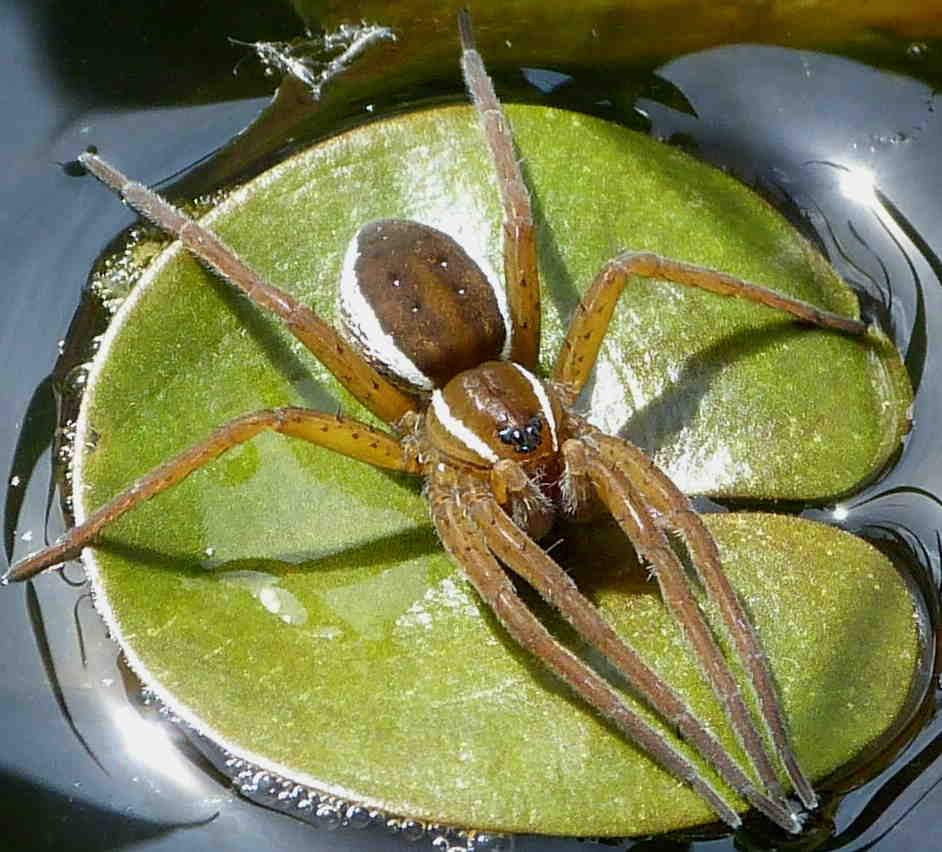The large-scale degradation and destruction of the lowland wetland habitats on which Dolomedes plantarius depends has made it a very rare species across much of its European range, and particularly in central and western Europe. It is currently one of only eight native European spider species (three occurring in GB) on the global Red List, where it has been classified as 'Vulnerable' to extinction since 1996 (WCMC 1996). This status requires reassessment under the more recent IUCN standards (version 3.1, 2001) but recent modelling of the impacts of future climate change on the species suggests that it will remain Vulnerable (Milano et al. 2022).
Dolomedes plantarius is covered by Red Lists (or Red Data books) and species protection legislation in more European countries than any other spider species. It is considered to be at risk of extinction in eight European Countries (and/or federal states), in some cases with this status automatically conferring legal protection. Seven European countries confer some degree of legal protection either directly on the spiders or on their habitat (Milano et al. 2021).
In Britain, the species was given Endangered status in the first British Red Data Book (Bratton 1991), published at a time when only two populations were known. After the discovery of the third population and changes to the assessment criteria to follow IUCN guidelines (WCMC 2012a & b), the 2017 British Red List (Harvey et al. 2017) reclassified it as Vulnerable.
Although Red Listing does not confer any legal protection in Britain, this species is given the highest level of protection available under the Wildlife and Countryside Act 1981 (as amended). Along with the Ladybird Spider Eresus sandaliatus, D. plantarius is listed on Schedule 5 of the Act, which includes protection from possession, sale or illegal killing or injuring, together with disturbance or destruction of the spiders and their habitat; a license is required for any activity which breaks these conditions. This level of protection is afforded to these two large and beautiful spider species in part because of their vulnerability to collectors - other less distinctive species at equal or even greater risk of extinction are not protected in the same way.
Dolomedes plantarius is also one of 30 British spider species that were the subjects of Species Action Plans as part of the UK Biodiversity Action Plan. This was produced in response to the international Convention on Biological Diversity, to which the UK was a signatory at the 1992 'Earth Summit' in Rio de Janeiro. The first Action Plan for D. plantarius was produced in 1999 and was updated several times, most recently in 2010 (BARS 2010). After that, the devolution of responsibility for biodiversity and environmental protection strategies to the GB regional Governments led to the development of new legislation. The former BAP species are now described as Species of Principle Importance, or Priority Species. Dolomedes plantarius is listed as a Priority Species in England under Section 41 of the NERC Act 2006 in England, and under Section 7 of the Environment Act 2016 in Wales.
References
Bratton, J. H. (ed.) 1991. British Red Data Book 3. Invertebrates other than Insects. Joint Nature Conservation Committee, Peterborough.
Duffey, E. 1958. Dolomedes plantarius Clerk, a spider new to Britain, found in the upper Waveney Valley. Transactions of the Norfolk and Norwich Naturalist's Society 18: 1-5.
Hayhow, D.B., Eaton, M. A., Stanbury, A.J., Burns, F., Kirby, W.B., Bailey, N., Beckmann, B., Bedford, J., Boersch-Supan, P.H., Coomber, F., Dennis, E. B., Dolman, S. J., Dunn, E, Hall, J., Harrower, C., Hatfield, J. H., Hawley, J., Haysom, K., Hughes, J., Johns, D.G., Mathews, F., McQuatters-Gollop, A., Noble, D.G., Outhwaite, C.L., Pearce-Higgins, J.W., Pescott, O.L., Powney, G.D. and Symes, N. 2019. The State of Nature 2019. The State of Nature partnership.
Harvey, P., Davidson, M., Dawson, I., Hitchcock, G., Lee, P., Merrett, P., Russell-Smith, A. & Smith, H. 2017. A review of the scarce and threatened spiders (Araneae) of Great Britain: Species Status No. 22, Natural Resources Wales, Cardiff.
Milano, F, Cardoso, P, Mammolo, S ., Smith, H. & Isaia, M. 2022. Trends in habitat suitability and conservation status of aquatic spiders in Europe. Biological Conservation 275 [109767]. https://doi.org/10.1016/j.biocon.2022.109767
Milano, F., Blick, T., Cardoso, P., Chatzaki, M., Fukushima, C. S., Gajdoš, P., Gibbons, A. T., Henriques, S., Macias-Hernandez, N., Mammola, S., Nentwig, W., Nolan, M., Pétillon, J., Polchaninova, N., Řezáč, M., Sandstrom, J., Smith, H., Wiśniewski, K., & Isaia, M. 2021. Spider conservation in Europe: a review. Biological Conservation 256, [109020]. https://doi.org/10.1016/j.biocon.2021.109020
WCMC 1996. 1996 IUCN Red List of threatened animals. IUCN Gland, Switzerland.
WCMC 2012a. IUCN Red List Categories and Criteria. Version 3.1, 2nd Edition, IUCN Species Survival Commission. IUCN, Gland.
WCMC 2012b. Guidelines for Application of IUCN Red List Criteria at Regional and National Levels. Version 4.0, IUCN Species Survival Commission. IUCN, Gland.
